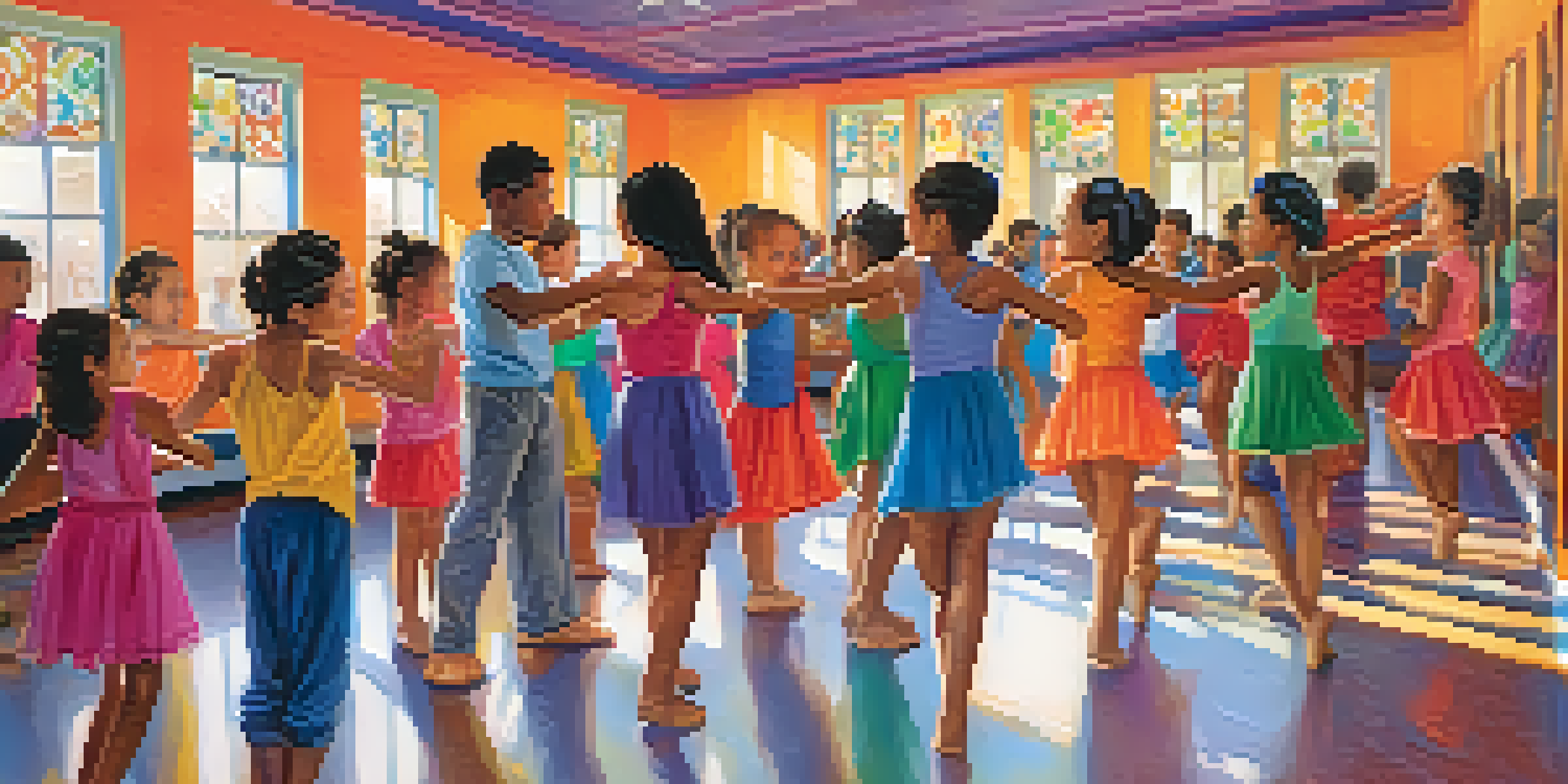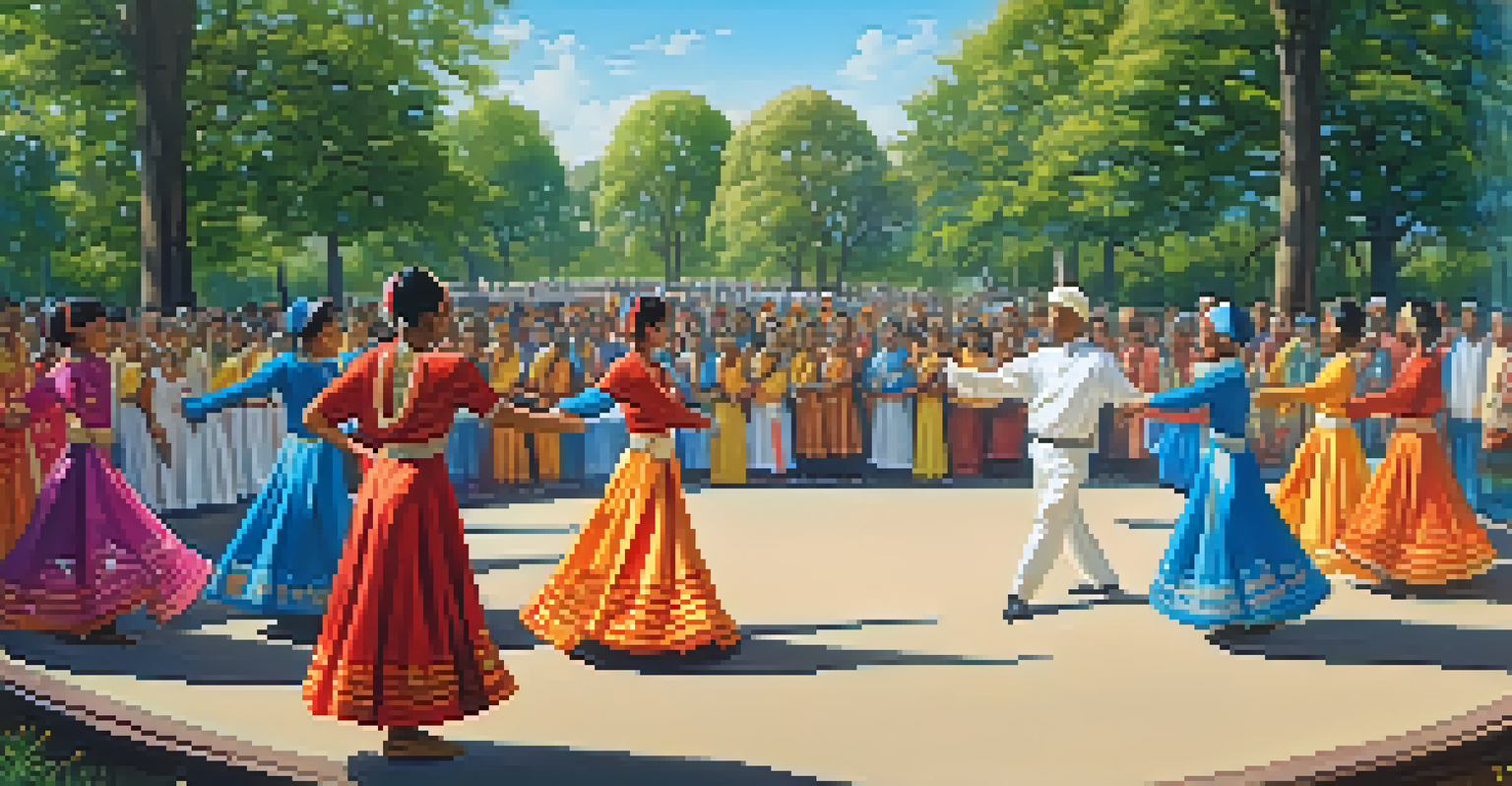Culturally Responsive Teaching in Dance Education Settings

Understanding Culturally Responsive Teaching in Dance
Culturally responsive teaching (CRT) is a framework that acknowledges and respects students' cultural backgrounds in the learning process. In dance education, this means integrating diverse dance forms and histories into the curriculum. By valuing the cultural stories behind different dance styles, educators can create a more inclusive and engaging learning environment.
Teaching dance is not just about technique; it's about creating an environment where every student feels valued and inspired to express their unique cultural identity.
Practicing CRT in dance settings goes beyond merely teaching various dance styles; it's about fostering an appreciation for the cultural significance behind these forms. For instance, when teaching hip-hop, educators can explore its roots in African American culture and its evolution over the decades. This connection not only enriches students' understanding but also instills pride in their own cultural identities.
Ultimately, CRT allows students to see themselves reflected in the curriculum, which can boost their confidence and motivation. When learners feel their backgrounds are acknowledged, they are more likely to participate actively and passionately in class. This approach cultivates a rich tapestry of perspectives that enhances the overall dance education experience.
The Importance of Diversity in Dance Education
Diversity in dance education is crucial as it mirrors the variety of cultures and experiences present in our society. When students are exposed to different dance forms, they not only learn new techniques but also develop a greater appreciation for the artistry involved. This exposure fosters creativity and innovation, as students can blend different styles and express themselves uniquely.

For example, incorporating ballet, salsa, and traditional African dances in the curriculum allows students to explore the technical aspects and cultural narratives of each style. This mixing of genres can inspire students to create original dances that reflect their own cultural identities and experiences. In this way, diversity serves as a catalyst for personal expression and artistic growth.
Culturally Responsive Teaching Benefits
Culturally responsive teaching in dance fosters inclusivity and enhances student engagement by valuing diverse cultural backgrounds.
Moreover, promoting diversity in dance helps break down stereotypes and misconceptions about various cultural practices. It encourages open dialogue among students about their cultural backgrounds, fostering respect and understanding. This not only enriches the classroom environment but also prepares students for a globalized world where cross-cultural collaboration is key.
Strategies for Implementing Culturally Responsive Teaching
Implementing culturally responsive teaching in dance education requires intentional planning and active engagement from educators. One effective strategy is to conduct cultural research on the dance forms being taught, ensuring that lessons are accurate and respectful. This research can inform how educators present the history, context, and significance of each dance style.
Dance is the hidden language of the soul, allowing us to connect with our cultural roots and share them with the world.
Additionally, creating a classroom environment that encourages sharing and dialogue about cultural experiences can enhance CRT. Inviting guest dancers from various backgrounds to share their expertise and stories can provide students with real-world connections to the art form. This not only enriches the curriculum but also builds a sense of community within the classroom.
Finally, educators should regularly seek feedback from students about their learning experiences. This can be done through discussions or anonymous surveys that allow students to express their thoughts on the inclusivity of the curriculum. By listening to student voices, educators can continuously adapt their teaching methods to ensure they meet the diverse needs of all learners.
Creating Inclusive Dance Classrooms
An inclusive dance classroom is one where all students feel welcomed and valued. This can be achieved by implementing ground rules that promote respect and understanding among peers. For instance, encouraging students to share their cultural dance experiences can foster a sense of belonging and encourage others to engage in the conversation.
In addition to setting a respectful tone, incorporating a variety of teaching methods can cater to different learning styles. Visual learners may benefit from demonstrations, while kinesthetic learners thrive on hands-on practice. By diversifying instructional methods, educators can ensure that all students have the opportunity to succeed and express themselves in ways that resonate with them.
Diversity Enhances Dance Education
Incorporating diverse dance styles cultivates creativity and personal expression, enriching students' artistic growth.
Finally, celebrating cultural events and traditions within the classroom can enhance inclusivity. For example, hosting a multicultural dance showcase allows students to share their cultural heritage through performance. This not only builds confidence but also creates an atmosphere of celebration and respect for diversity.
The Role of Dance in Cultural Identity
Dance is a powerful medium for expressing cultural identity, allowing individuals to tell their stories through movement. In dance education, fostering this connection can help students explore their own backgrounds while gaining insight into others. This exploration can lead to a deeper understanding of the world and its diverse cultures.
For many students, dance serves as a bridge between their cultural heritage and their current experiences. By integrating traditional dances from their cultures into lessons, educators can empower students to take pride in their roots. This empowerment not only enhances their dance skills but also contributes to their overall self-esteem and sense of belonging.
Moreover, recognizing the role of dance in cultural identity can encourage students to be advocates for their cultures. When students feel their dance traditions are celebrated and valued, they are more likely to share them with others. This sharing fosters cultural exchange and learning, enriching the dance community as a whole.
Challenges and Solutions in Culturally Responsive Dance Education
While culturally responsive teaching is essential, it does come with its challenges. One common issue is the potential for cultural appropriation, where elements of a culture are used without understanding or respect. Educators must navigate this delicate balance by thoroughly researching and teaching the cultural significance behind the dance forms they include in their curriculum.
Another challenge is the lack of resources or training for educators in culturally responsive practices. To address this, schools should invest in professional development opportunities that focus on CRT in dance education. This can include workshops, conferences, or collaboration with cultural organizations to ensure educators are well-equipped to teach with sensitivity and awareness.
Overcoming Challenges in CRT
Addressing challenges like cultural appropriation and resource limitations is essential for effective culturally responsive dance education.
Finally, resistance from students or parents who may not understand the value of culturally responsive teaching can be a barrier. Open communication is key here; educators should explain the benefits of CRT and involve families in discussions about the curriculum. By fostering an open dialogue, educators can create a supportive community that values cultural diversity in dance.
The Future of Culturally Responsive Teaching in Dance
The future of culturally responsive teaching in dance education looks promising as more educators recognize the importance of inclusivity. With the rise of digital platforms, there are now more opportunities for students to access diverse dance forms from around the world. This accessibility allows for richer learning experiences as students can explore and learn from a multitude of cultural perspectives.
As educators continue to advocate for CRT, we can expect to see a shift in dance curriculums that prioritize cultural relevance and social justice. This evolution will not only enrich students' learning experiences but also prepare them to be culturally competent individuals in a diverse society. The goal is to create dance environments that celebrate differences while promoting unity through the art of movement.

Ultimately, as culturally responsive teaching becomes more ingrained in dance education, the benefits will extend beyond the classroom. Students will carry these lessons into their lives, fostering a greater appreciation for diversity in their communities. The future holds the potential for a dance landscape that is vibrant, inclusive, and reflective of the rich tapestry of human experience.